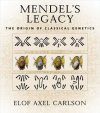![Mendel's Legacy Mendel's Legacy]()
Click to have a closer look
About this book
Contents
Related titles
About this book
Traces the roots of genetics in breeding analysis and studies of cytology, evolution, and reproductive biology that began in Europe but were synthesized in the United States through new Ph.D. programs and expanded academic funding. Carlson argues that, influenced largely by new technologies and instrumentation, the life sciences progressed though incremental change rather than paradigm shifts, and he describes how molecular biology emerged from the key ideas and model systems of classical genetics.
Contents
Introduction - what is classical genetics?; the tributaries of classical genetics; the American amalgam; the first decade of classical genetics; the organism of choice: drosophila; the domination of biology by classical genetics; classical genetics examines homo sapiens and society.
Customer Reviews
Out of Print
By: Elof Axel Carlson
332 pages, Illus
Several outstanding features of this book will make it useful for specialists and non-specialists alike. One is the attempt to show how classical genetics was involved with political issues in the twentieth century, using three examples: eugenics (1883-1945), the Lysenko controversy in the Soviet Union (1930-1960), and the controversy over the genetic effects of radiation (1946-1970). Another noteworthy feature is the use of chronological tables for the whole field (at the beginning of the book), as well as for specific sub-topics, such as contributions to the chromosome theory of sex determination, or geneticists' educational background. A third valuable feature is the author's liberal use of high-quality illustrations, including photographs of many geneticists seldom pictured before, original figures from published papers, and the title pages of important papers and books. The publishers, Cold Spring Harbor Press, have produced an attractive and useful book. Nature This book is a must for biology teachers in both high school and college who enjoy reading the historical background that goes into major accomplishments, and want to convey a fascinating story to their students. Besides the historical account, the author explains at the end of the book the significance of classical genetics as a case study on the history of science. He asserts that classical genetics does not constitute a 'paradigm shift' but is an elegant experimental science that has evolved through new technologies. Moreover, Carlson humbly states that the history of classical genetics 'is not an anomaly in the history of science [but] accurately depicts how science is done.' I certainly agree. The American Biology Teacher Mendel's Legacy has many virtues. Given its span and the amount of material covered, it is very light and readable. Every chapter is organized in small sections with well-identified headings that make them self-contained units. An interesting feature of the book is the illustrations. They are abundant and interesting, beautifully woven with the text and an excellent complement to the literary account. I would say that together they are the best-published gathering of pictures of the history of genetics. Carlson has written a classic that will serve as reference and resource to historians and geneticists. BioEssays



































